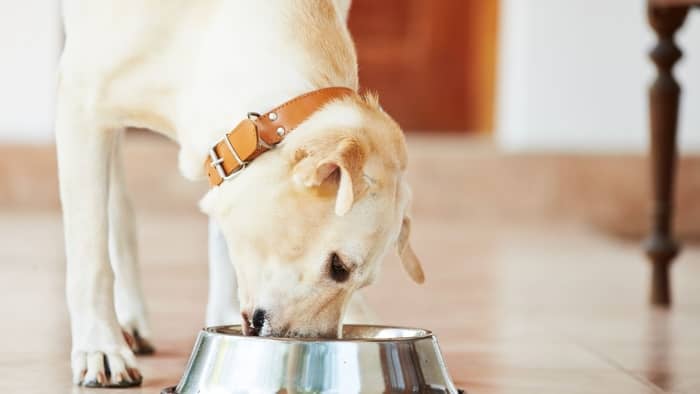Last Updated on November 11, 2023 by Linda Richard
Of all the fruits and foods dogs can and cannot eat, you’d probably think mango is of the latter. It’s a tropical fruit and one that wolves – our dogs’ ancestors – didn’t evolve eating. So, are mangoes good for dogs or are they toxic?
If they are edible, what are the rules and proportions you should follow before giving your dog mango? And, if it’s inedible, what should you do if your dog has accidentally eaten some mango? We’ll go over all that below.
Table of Contents
Can Dogs Have Mangoes?
Mangoes are indeed edible for dogs. This can feel counterintuitive at first but there really isn’t anything toxic for dogs in mangoes. The peel and pit should be removed, of course, but the flesh of the fruit is perfectly fine.
The only “harmful” part of the mango’s flesh is the sugar in it as is the case with any other fruit. However, as long as you don’t give your dog too much of it (and your dog doesn’t have any diabetes or other health issues) everything should be fine.

Are mangoes good for dogs?
Mangoes aren’t just ok for your dog to eat. An argument can be made that they are even good for your dog. Mangoes are incredibly high in vitamins A, B6, C, and E – all vitamins dogs benefit from just as we do.
The mango’s meat is also very rich in fibers which also helps with the dogs’ digestive tract. The sugar in the mango is problematic in large quantities but it also gives it the sweet taste that most dogs will love. This makes mangoes a fantastic training or exercise treat as long as it’s only given in moderation.
Can dogs eat the mango peel or pit?
So, are mangoes good for dogs? Yes, but only as long as you remove the fruit’s pit and peel. They are not technically toxic for dogs aside from the small amount of cyanide in the pit.
That cyanide shouldn’t be enough to cause any direct health problems but it’s still not recommended. The bigger problem with the mango’s pit, however, is that it’s a pretty major choking hazard for any dog, even for larger breeds like the Labrador Retriever.
The peel, on the other hand, is neither a choking hazard nor does it have cyanide. It is pretty hard, however, and it can be difficult to digest. So, removing both the pit and the peel is strongly recommended.
As an additional tip, it’s also smart to only give your dog ripe and soft mangoes. A mango that isn’t fully ripe yet is going to be too hard for your dog to chew. So, most dogs will just swallow such hard mango pieces whole.
In those cases, even the fruit’s flesh can be a choking hazard. That’s why it’s important to only give your dog soft mangoes and to cut them into small pieces.
Can dogs have dried mango?
Just as with fresh mangoes, dried mango is also safe for dogs. The peel and pit will, of course, be removed or the peel will have become softer in the drying process, making the dried fruit perfectly safe.
How much mango or dried mango can I give my dog?
The only problem with dried mangoes is the same with any other dried fruit for either dogs or people – too much sugar per pound of fruit. In essence, dried fruits are much smaller and lighter than fresh fruit but all their sugar is still inside, making it much more concentrated. So, giving your dog any more than a bite or two is really ill-advised.
If your dog is in perfect health, a third piece of the dried fruit probably still won’t be that much of an issue. However, if you give your dog that much-dried mango regularly you can expect to see some health problems over time due to all the excess sugar.
As for fresh mango – you can be a bit more liberal with that as long as the fruit is soft, cut into small pieces, and both the pit and peel have been removed. Even then, however, going over a couple of pieces for small dogs or 3-4 pieces for larger breeds is not recommended. You just don’t want to give your dog too much sugar.
What can happen to my dog if he/she’s eaten too much mango?
There are two types of problems you can expect to see if you overfeed your dog with mango. Those are the short-term issues and long-term health problems. The former are usually just digestive tract issues that can come from the sudden intake of sugar. These are typically just bellyaches, diarrhea, and vomiting.
The long-term issues can be more problematic. These include diabetes, obesity, hyperglycemia, and other concerns related to the regular consumption of sugar. This is why it’s important to just use mango as an occasional, high-value treat for your dog and not as a regular thing.
Be careful when leaving mango or other fruits lying around in the kitchen!
What to do if I’ve given my dog too much mango?
If your dog starts having bellyaches and diarrhea from eating too much sugar, it’s wise to call your vet. An immediate visit probably won’t be necessary if the dog is generally healthy. The aches and diarrhea should pass after a while.
But it’s still wise to contact your vet just in case. If the dog has choked on a mango pit or a large and hard mango piece, however, it’s strongly recommended to get to your vet as soon as possible.
So, Are Mangoes Good For Dogs And When And How Should You Give Them To Your Pooch?
Mangoes are safe and good for healthy canines as long as they are given to them smartly and in moderation. Only give your dog ripe (soft) or dried mangoes with both the pit and the peel removed. Also, only give your dog mangoes rarely and in moderation to avoid the risks that come from consuming too much sugar.
Read more about Can Dogs Eat Goat Cheese And Why It’s Controversial?

